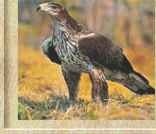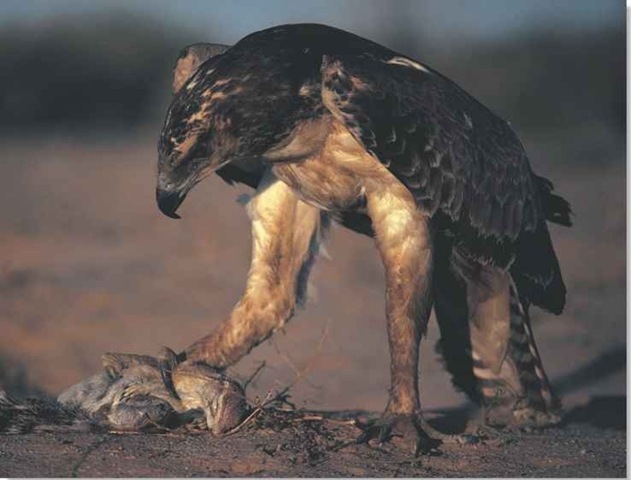ORDER
Falconiformes
FAMILY
Accipitridae
GENUS & SPECIES
key features
• Largest of all the African eagles
• Extremely powerful, with the strength to kill a small-antelope
• Eyesight so sharp it can spot large prey from about 3 miles away
• Hunts over an area in excess of 80 sq. miles
where in the world!
Found throughout much of Africa south of the Sahara Desert; avoids heavily forested areas and is most common (but not numerous) on savannah grasslands

LIFECYCLE
Soaring high above the African grasslands on-rising currents of warm air, the mighty martial eagle is always alert, poised to dive with deadly precision on its prey.
Habitat
The eagle’s aerial view of its habitat is a rolling savannah with occasional trees dotting the landscape. It often flies over open woodland and along river valleys, hoping to spot prey unprotected by cover.
The martial eagle uses one of several favored trees for overnight roosting and regular nest sites. Important, too, is an unfailing supply of water for the regular bathing it needs.

Desert Grassland Semidesert Coniferous forest
Tropical forest
Evergreen/deciduous woodland Range of the martial eagle
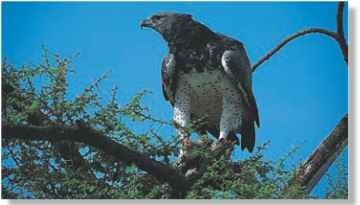
A Eating aloft Perched in the crown of a tree, the eagle uses its hooked bill to shred strips of flesh from a carcass.
Killing fields Open grassland is an ideal habitat for the eagle, as it offers little shelter for its prey.
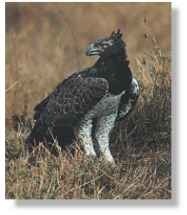
Conservation
The martial eagle is a rare sight because each pair of I eagles ranges over a huge area in search of prey and dislikes competition from other pairs. Usually seen over savannah grassland, the eagle sometimes hunts over farmland; some farmers believe it attacks livestock and will shoot it on sight. A greater danger to this bird is habitat destruction. The use of pesticides on crops is also a grave threat, which affects the species’ breeding success.
Breeding
A female rarely lays more than one egg each season; breeding pairs invest a lot of time in their chick. For the first two months, the smaller male does most of the hunting; the female guards the nest. On his return, the male passes the food to his mate rather than directly to the chick. This lets her claim a share of the spoils.
After six months or so, the eaglet is ready to take to the air. Once it has made its first flight, it spends more and more time aloft. It flies alongside its parents, sharing their prey and learning how to hunt for itself. After a few successful kills, the young eagle leaves to find a territory of its own.
Behavior
The martial eagle hunts by sight so, like all birds of prey, it waits until the sun is up before leaving its tree roost to patrol the skies.The eagle also waits to take advantage of the sun’s warmth, because the morning sun heats the ground, causing columns of warm air to rise.This broad-winged eagle is perfectly adapted for soaring on these thermals like a glider
Launching itself into the air, the eagle flies over its domain until it senses a warm upcurrent, then starts to circle. It climbs ever higher, adjusting its slotted flight feathers to harness the wind. All the time it scans the ground for prey. If none can be found, it slips out of the thermal and glides or flies across country until it finds anotherthermal. The eagle may travel vast distances every day, covering a home range of 80 sq. miles or more with little effort.
Take-off From an acacia tree perch, the eagle launches into the sky. Once airborne, it catches a thermal and soars to a great height.

A Precious young
A female patiently shields her chick from the sun.
Youthful warrior This juvenile isn’t ready to leave the nest, but can probably kill for itself.
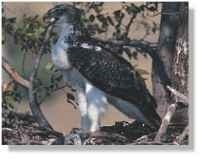
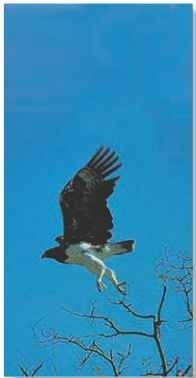
• The martial eagle needs to bathe daily to keep its flight feathers clean and working efficiently.
• If an eagle attacks a young antelope, it may have to deal with its mother. The eagle spreads its wings, hisses and lashes out with its sharp talons to drive her away.
• The martial eagle’s eyesight is superb. One was seen to swoop down from a hilltop and seize a guinea fowl a mile away.
Food & hunting
An eagle will attack virtually any mammal, reptile or bird it can overpower When it selects its prey, the eagle folds its wings slightly and dives, accelerating as it rushes downward. At the last moment, it brakes hard with wings spread and thrusts its talons forward, but still strikes with enough force to tumble and even kill its prey The eagle usually eats at the site of the kill. It may feed from a big carcass for up to five days, roosting on a nearby tree between meals.
Out of the blue
By sheer force of impact, a-diving eagle can strike down larger prey, such as young gazelle. Smaller prey is usually killed outright by the blow.
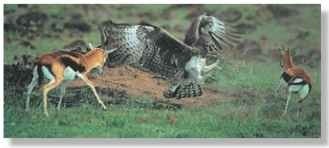
swooping for the kill

Reconnaissance…
The eagle soars high above the ground, riding the breezes and relying on its superb vision to detect movement below.

Attack…
A long, shallow dive brings the eagle swooping down on its prey. It tilts and turns in the rushing wind to adjust its course.
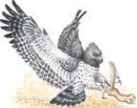
Strike…
The eagle brakes sharply, and too late its prey realizes its plight: the needle-sharp talons lock forward and slam home with fatal force.

Success
Straddling its prey, the eagle tears flesh with its hooked bill. If the carcass is small, the eagle may take it into a nearby tree.
PROFILE
Martial Eagle
With its rapier-sharp talons, the martial eagle makes a fearsome aerial predator, swooping down to strike its prey with terrible force.
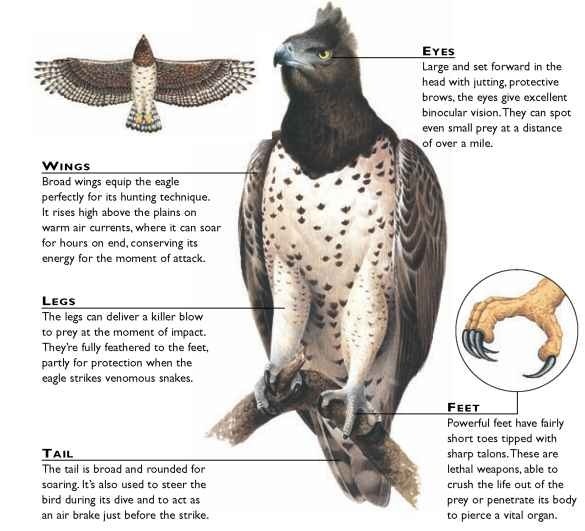
Creature comparisons
All eagles have sharp, hooked bills to tear up prey. The bill’s shape reflects the eagle’s diet. The bald eagle of North
America has a sharply hooked bill for ripping through the scales of slippery fish. The golden eagle’s bill is a little less hooked, like the martial eagle’s. It’s better suited to the tough skin of rabbits, hares and birds that form a large part of its diet.

Bald eagle

Golden eagle

Martial eagle
| VITAL Weight |
STATISTICS 11-13 lbs. |
| Length | 32-34″ |
| Wingspan | 7-9′; female larger than ‘ male |
| sexual Maturity .; | 5-6 years |
| Mating . Season | Varies with location |
| Number of Eggs | Rarely more than 1 |
| Incubation : Period | 55 days |
| Birth Interval | 1-3 years |
| Typical Diet | Young antelope, ground squirrels, hares, guinea fowl, snakes, lizards |
| Lifespan | About 16 years |
RELATED SPECIES
• The martial eagle is in the family Accipitridae, which includes hawks, harriers, Old World Vultures and kites. This is also the same family as the bald eagle and Bonelli’s eagle (below) of Europe, Africa and Asia.
